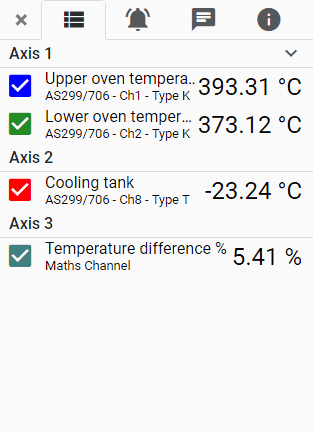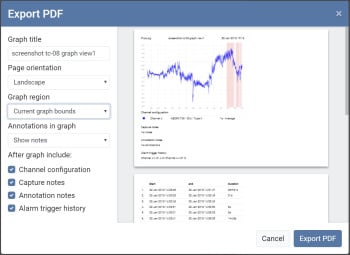PicoScope 7 Software
Available on Windows, Mac and Linux
PT-104
High-accuracy data logger
The PT-104 is a four-channel temperature measuring data logger. It offers the ultimate in resolution (0.001 °C) and accuracy (0.015 °C). Along with temperature it can also be used to measure resistance.


PicoLog 6 is a complete data acquisition software package for the PT-104 precision temperature data logger. It provides a visual, easy-to-use interface allowing you to quickly set up simple or complex acquisitions and record, view and analyze data.
Designed from the ground up to be intuitive from the outset, PicoLog 6 allows you to set up the logger and start recording with just a few clicks of the mouse, whatever your level of data logging experience.
From here, starting a capture is simple: plug in the logger, add a channel, press Record, and you’re logging! PicoLog 6 also includes a number of additional features to cater for more advanced data logging needs.

A simple vertical menu bar on the left of the screen provides permanent access to the main program menus and view modes of PicoLog 6 without pausing capture.
The permanent vertical navigation bar gives access to the following menus:

Within the Device setup and capture menu are the Device config, Graph display and Table views. These make it easy to set up and acquire data from a multichannel acquisition system, even with multiple different PicoLog data loggers and hundreds of channels. In the Device config view you can instantly see the status of data loggers, acquisition channel settings and math channel setup. Each detected device is depicted with its enabled channels. Simply move or copy device configurations to set up larger multiple-logger systems, swap out loggers during capture or share configurations.
From this screen you can view and adjust settings such as adding graph axes, per-channel scaling factor, alarms, notes, graph annotations, channel naming and color, sample mode and sample interval.

The Channel and Axes settings menu is visible in both the Device settings and Capture graph views. Once a channel is enabled and settings confirmed, you can view its connection status at a glance, along with alarm condition and current live measurement. In this menu, you can also configure alarms and view graph annotations and capture info.

Viewing your data in a graph is fundamental to data acquisition applications. The PicoLog 6 graph view makes it easy to view captures, zoom and pan through large datasets, record alarm history and display when alarms occurred. It also allows you to annotate the graph with your notes and observations.
Adding additional graph axes is also essential for multi-channel logging applications where measurement units are different for every channel, or when the channels are measuring values at opposite ends of the range. For example, simultaneously measuring an internal furnace temperature of over 1000 °C and the ambient temperature at the same time requires two axes so that the detail of both is visible. You can view up to four axes with different ranges at a time.

Maybe you’re measuring the temperature of a microbiological culture in an incubator, or strain on a concrete bridge in high winds; you’ll need to be informed when a reading exceeds acceptable tolerances. In PicoLog 6, you can set up an alarm to alert users when a parameter goes out of range. This can be configured to play a sound, display visual alerts on the screen, run a specified application such as an email or SMS client, and automatically annotate the capture graph to mark when the alarm happened and its duration.
PicoLog 6 alarms can also trigger a digital output on devices with supporting hardware, such as the PicoLog 1000 Series, ADC-24 and DrDAQ. You can even trigger a digital output from one of these devices based on an alarm condition from another connected logger without digital outputs, such as a TC-08.
It is also possible to set an alarm when a device becomes disconnected: an alarm is turned on, the event recorded and the graph annotated to show that the lost data was due to device disconnection.

Some applications require the recording and graphing of a calculated parameter containing data from one or more measurement channels. PicoLog 6 is equipped with an equation editor to perform simple calculations such as A–B, or more complex functions such as log, sqrt, abs, round, min, max, mean and median.
Math channels are treated like any normal channel, so you can perform functions like alarms, graphing and annotations on them.
At the heart of PicoLog 6 is a robust file system that is resistant to data loss and corruption. If the computer is shut down and rebooted, PicoLog resumes capturing without losing the previously stored data. Data is stored automatically without the need to provide a file name and location – but if you wish to save data to a file, you can, even in mid-capture. This makes it easy to share data with fellow PicoLog users.
The file system can store huge datasets limited only by the size of the hard disk or SSD on your computer!
Another major step forward is native support for 32-bit and 64-bit Windows, various Linux distributions (64-bit only) and macOS. The new .picolog file format is compatible across all operating systems. Since anyone can download and install PicoLog 6 for free, you can share saved .picolog files with co-workers, customers and suppliers for offline post-analysis.

When you’re ready to export the data, you have several options. First, save the .picolog file and close the acquisition. You can save files with custom search tags to make them easier to categorize and locate later.
Exporting large datasets to CSV can often be troublesome due to file size limitations, so PicoLog 6 includes a suite of export options to narrow down the size of the whole dataset. These include downsampling, selecting channels to export or even restricting the export region to the zoomed area on screen.
Want to export a screen shot? PicoLog 6 includes a feature to export the graph as a PDF: again, select either the entire capture or the zoomed area of interest. The export to PDF format also includes options to include alarm trigger history, annotations, channel configuration and capture notes, for a complete capture report.

If you don't yet have a PicoLog data logger, you can still use PicoLog 6 to view saved waveforms and try out its other features with the built-in demo mode.
You can enable up to three virtual instances of each PicoLog data logger with simulated live data. All the features of the PicoLog 6 software are then available for you to try before you buy.

Pico Technology data loggers work great when USB connected to PCs running Windows, macOS and Linux, and now with support for Raspbian OS on armhf processors, we support Raspberry Pi computers.
Optimized and tested on the new Raspberry Pi 4 on Raspbian Buster, the PicoLog 6 data logging software package provides a visual, easy-to-use interface allowing you to quickly set up simple or complex acquisitions and record, view and analyze data. It's the same fully functioning software that runs on Windows, macOS and Linux.
Coupled with a Raspberry Pi, this new PicoLog 6 package expands the flexibility and opens the door for Pico's data loggers to be used in new and different ways:
.jpg)
More information on Raspberry Pi extends data logger capability >>